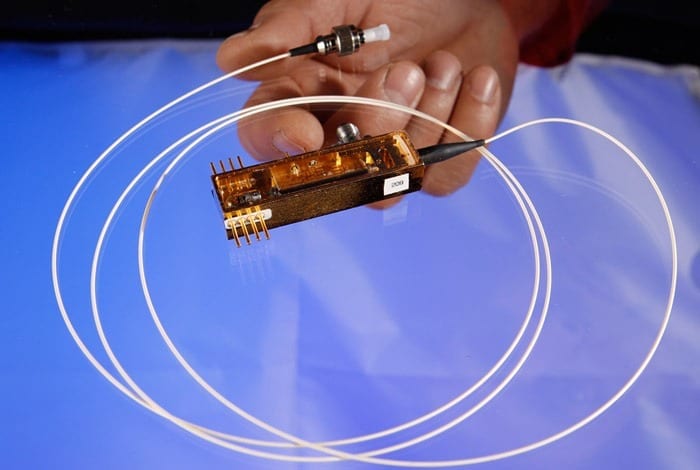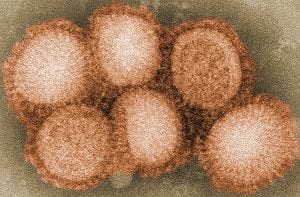
LANL’s quantum cryptography team successfully completed the first-ever demonstration of securing control data for electric grids using quantum cryptography.
Recently a Los Alamos National Laboratory quantum cryptography (QC) team successfully completed the first-ever demonstration of securing control data for electric grids using quantum cryptography.
The demonstration was performed in the electric grid test bed that is part of the Trustworthy Cyber Infrastructure for the Power Grid (TCIPG) project at the University of Illinois Urbana-Champaign (UIUC) that was set up under the Department of Energy’s Cyber Security for Energy Delivery Systems program in the Office of Electricity Delivery and Energy Reliability.
Novel methods for controlling the electric grid are needed to accommodate new energy sources such as renewables whose availability can fluctuate on short time scales. This requires transmission of data to and from control centers; but for grid-control use, data must be both trustworthy and delivered without delays. The simultaneous requirements of strong authentication and low latency are difficult to meet with standard cryptographic techniques. New technologies that further strengthen existing cybersecurity protections are needed.
Quantum cryptography provides a means of detecting and defeating an adversary who might try to intercept or attack the communications. Single photons are used to produce secure random numbers between users, and these random numbers are then used to authenticate and encrypt the grid control data and commands. Because the random numbers are produced securely, they act as cryptographic key material for data authentication and encryption algorithms.
At the heart of the quantum-secured communications system is a unique, miniaturized QC transmitter invention, known as a QKarD, that is five orders of magnitude smaller than any competing QC device. Jane Nordholt, the Los Alamos principal investigator, put it this way: “This project shows that quantum cryptography is compatible with electric-grid control communications, providing strong security assurances rooted in the laws of physics, without introducing excessive delays in data delivery.”
A late-2012 demonstration at UIUC showed that quantum cryptography provides the necessary strong security assurances with latencies (typically 250 microseconds, including 120 microseconds to traverse the 25 kilometers of optical fiber connecting the two nodes) that are at least two orders of magnitude smaller than requirements. Further, the team’s quantum-secured communications system demonstrated that this capability could be deployed with only a single optical fiber to carry the quantum, single-photon communications signals; data packets; and commands. “Moreover, our system is scalable to multiple monitors and several control centers,” said Richard Hughes, the co-principal investigator from Los Alamos.
The Latest on: Quantum cryptography
[google_news title=”” keyword=”Quantum cryptography” num_posts=”10″ blurb_length=”0″ show_thumb=”left”]
via Google News
The Latest on: Quantum cryptography
- DigiCert has announced World Quantum Readiness Dayon May 3, 2024 at 9:40 am
DigiCert has announced the first World Quantum Readiness Day. It will take place on September 26, 2024. Its goal is to highlight the need for existing ...
- DigiCert establishes World Quantum Readiness Day to propel global organisations toward future-proof securityon May 2, 2024 at 5:00 pm
It underscores the urgency of adopting post-quantum cryptography (PQC) standards, which are currently being developed by pioneering institutions such as NIST to protect against future quantum-related ...
- Keysight hones post-quantum algorithm testingon May 2, 2024 at 3:49 pm
Keysight announced additional testing capabilities for its Inspector security platform to assess the robustness of post-quantum cryptography.
- DigiCert Establishes World Quantum Readiness Day to Propel Global Organizations Toward Future-Proof Securityon May 2, 2024 at 6:05 am
Digital Trust leader spearheads initiative to educate and prepare organizations for quantum computing Are you ready for quantum? The first annual World Quantum Readiness Day is set for Thursday, ...
- Quantum Cryptography Market Innovative Strategies for Harnessing Future Market Size Growthon May 1, 2024 at 6:12 pm
The “Global Quantum Cryptography Market 2024“ research describes the competitive market environment based on production volume, profits, and sales. The report covers even the ...
- Arqit announces collaboration to deliver out-of-the-box post-quantum cryptography solutionson April 29, 2024 at 6:00 am
LONDON, April 29, 2024 (GLOBE NEWSWIRE) -- Arqit Quantum Inc. (Nasdaq: ARQQ, ARQQW) (Arqit), a leader in quantum-safe encryption, today announced the creation of the World’s First Quantum-Safe, 1.89 ...
- Google Chrome's new post-quantum cryptography is causing some issueson April 29, 2024 at 3:00 am
Some sites are refusing to work with Chrome 124’s default quantum-resistant hybridized tool – here’s what to do.
- Google Chrome's new post-quantum cryptography may break TLS connectionson April 28, 2024 at 7:19 am
Some Google Chrome users report having issues connecting to websites, servers, and firewalls after Chrome 124 was released last week with the new quantum-resistant X25519Kyber768 encapsulation ...
- Quantum Cryptography market is projected to grow at a CAGR of 29.3% by 2034: Visiongainon April 26, 2024 at 6:22 am
Visiongain has published a new report entitled Quantum Cryptography Market Report 2024-2034: Forecasts by Component (Software, Hardware), by Software (Encryption Algorithms, Key Management Solutions, ...
- Space Age Security: How Satellites Could Extend Quantum Encryption Globallyon April 25, 2024 at 12:11 am
Quantum cryptography enables secure communication over large distances. How can we guarantee that data sent over the internet is only accessible to its intended recipient? Currently, our data is ...
via Bing News










